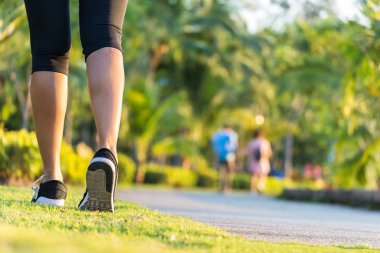
Best Time For Walking To Lose Weight (8 Helpful Guidelines)
Best time for walking to lose weight, Finding the perfect time to walk for weight loss can transform a simple stroll into a powerful tool for shedding pounds. Whether you’re an early riser or a night owl, timing your walks to sync with your body’s natural rhythms can maximize fat burning and keep those extra pounds at bay. Discovering the optimal moment to lace up your sneakers not only boosts your metabolism but also enhances mood and energy levels, making your weight loss journey more effective and enjoyable.

Best Time For Walking To Lose Weight
The best time for walking to lose weight is in the morning, before breakfast. This is when your body is in a fasted state, making it more likely to burn stored fat for energy. Morning walks can boost your metabolism, helping you burn more calories throughout the day. Additionally, starting your day with physical activity sets a positive tone, encouraging healthier choices and consistency in your weight loss journey.
Morning Walks: A Fat-Burning Powerhouse
Morning walks, often referred to as fasted cardio, are highly effective for weight loss. Many fitness enthusiasts believe that walking in the morning on an empty stomach can accelerate fat burning. This is because your body’s glycogen levels are lower after a night of fasting, prompting it to tap into fat stores for energy. The calm and peaceful atmosphere in the morning also makes it easier to focus on your workout, helping you stay consistent.
Walking outdoors at this time allows you to soak in the sunrise and breathe in fresh air, which can enhance your mood and mental clarity. Additionally, morning exercise helps regulate your circadian rhythm, leading to better sleep, which is crucial for weight management. Many people find that a morning walk energizes them for the day ahead, promoting a more active lifestyle overall. Whether you’re aiming to lose weight or maintain a healthy lifestyle, incorporating a brisk walk into your morning routine can be a game-changer.
Evening Walks: A Calorie-Burning Alternative
Evening walks also have their own set of benefits, especially for those who aren’t morning people. Walking after dinner can aid digestion and prevent the accumulation of fat from a heavy meal. The cooler evening air can make walking more comfortable, and it’s often easier to fit into a busy schedule. Moreover, walking in the evening can help relieve stress, which is a common barrier to weight loss. By incorporating a consistent walking routine, whether in the morning or evening, you can effectively boost your calorie burn and reach your weight loss goals.
Midday Walks: Breaking Up the Day
For those with a flexible schedule, midday walks can be a great option. Taking a break during lunch to walk can help counteract the effects of prolonged sitting, which is often linked to weight gain. A brisk walk in the middle of the day can refresh your mind, increase your productivity, and keep your metabolism active. Plus, the daylight exposure can boost your vitamin D levels, supporting overall health and well-being.
Morning Walking
Benefits of Morning Walking
Morning walking offers numerous benefits, making it an excellent way to start the day. One of the primary advantages is its ability to boost metabolism, which helps increase the body’s metabolic rate throughout the day. By kick-starting the metabolism early, morning walks aid in burning calories more efficiently, contributing to weight management and overall health.
Additionally, morning walks significantly increase energy levels, providing a natural, invigorating start to the day. The fresh air and gentle exercise awaken the body, enhancing alertness and focus. Beyond the physical benefits, morning walks are also highly effective in improving mental health. Engaging in this daily routine helps release endorphins, the body’s natural mood elevators, which can reduce stress, anxiety, and symptoms of depression. As a result, morning walking not only supports physical wellness but also contributes to a more positive and balanced mental state.
Impact on Weight Loss
Morning walking, especially in a fasting state before breakfast, can significantly impact weight loss. Walking on an empty stomach encourages the body to utilize stored fat as its primary energy source, enhancing fat oxidation and potentially leading to more effective weight loss. This practice taps into the body’s fat reserves, making it an efficient strategy for those aiming to shed extra pounds.
Additionally, establishing a morning walking routine can be crucial for long-term success. Consistency is key in weight loss, and by making morning walks a daily habit, individuals can set a positive tone for the day, boosting their metabolism and maintaining momentum throughout their fitness journey. Regular morning walks also help in building discipline, making it easier to stick to other healthy habits and achieve sustained weight loss over time.
Considerations
Morning walking is an excellent way to start the day with both physical and mental benefits. One crucial consideration is hydration; drinking water before your walk ensures your body is adequately hydrated, which can help maintain energy levels and improve overall performance. It’s generally recommended to drink a glass of water about 30 minutes before heading out.
Additionally, if you find that you need a bit more fuel before your walk, a light pre-walk snack can be beneficial. Opt for easily digestible options like a banana, a small handful of nuts, or a piece of whole-grain toast. Eating about 30 minutes to an hour prior to your walk can help provide a steady energy supply without causing discomfort or sluggishness. Combining proper hydration with a thoughtful snack can enhance your walking experience, making it a more enjoyable and effective activity.

Afternoon Walking
Benefits of Afternoon Walking
Afternoon walking offers several benefits that can positively impact overall health. One key advantage is improved digestion; a gentle walk after a meal helps stimulate the digestive system, enhancing the process of breaking down food and aiding in nutrient absorption.
Additionally, walking in the afternoon can increase your body temperature, which in turn boosts calorie burning and supports weight management. This moderate rise in temperature helps the body utilize energy more efficiently. Another significant benefit is that it provides a valuable break from prolonged periods of sitting.
By interrupting sedentary behavior, afternoon walks can mitigate some of the adverse effects associated with sitting for extended periods, such as decreased circulation and muscle stiffness. Integrating regular afternoon walks into your routine can thus contribute to better digestion, enhanced calorie burning, and overall improved physical well-being.
Impact on Weight Loss
Afternoon walking, particularly after lunch, can have significant benefits for weight loss and overall health. Engaging in a walk post-meal helps regulate blood sugar levels, as physical activity aids in the efficient processing of glucose, reducing the likelihood of insulin spikes and crashes. This not only helps in managing weight but also contributes to a more stable energy level throughout the day.
Additionally, afternoon walks can combat the common energy slump that often follows lunch by stimulating circulation and increasing alertness. The gentle exercise boosts endorphins, leading to enhanced mood and mental clarity, which can help maintain productivity and focus in the latter half of the day. Overall, incorporating a post-lunch walk into your routine can be a simple yet effective strategy for supporting weight management and sustaining energy levels.
Considerations
Afternoon walking can be a refreshing and beneficial activity, but it’s important to consider a few key factors to maximize its advantages and avoid discomfort. Timing plays a crucial role; it’s best to schedule your walk after a meal, allowing time for digestion to minimize any potential stomach discomfort. Ideally, wait about 30 minutes to an hour post-meal before heading out.
Additionally, be mindful of sun exposure, particularly during peak hours when UV rays are strongest, typically between 10 a.m. and 4 p.m. To protect your skin, wear sunscreen, a hat, and sunglasses, and opt for lightweight, breathable clothing. By taking these considerations into account, you can enjoy your afternoon walk comfortably and safely, reaping its numerous health benefits while safeguarding yourself from excessive sun exposure.
Evening Walking
Benefits of Evening Walking
Evening walking offers a host of benefits that make it a valuable addition to your daily routine. As a relaxing way to unwind after a demanding day, a leisurely evening stroll can effectively alleviate stress, providing a much-needed mental break and a moment of tranquility. This gentle exercise not only aids in reducing tension but also contributes to improved sleep quality.
Additionally, evening walks present a wonderful opportunity for social interaction—whether it’s joining a group of friends, taking a stroll with family, or simply enjoying the company of a loved one, these outings can strengthen relationships and foster a sense of community.
Impact on Weight Loss
Evening walking can be a powerful tool for weight loss, with benefits that extend beyond mere calorie burning. One significant advantage is its role in maintaining metabolism throughout the night. Engaging in a moderate evening walk helps to keep the metabolic rate elevated, which can aid in the continued burning of calories even after the activity has ended.
Additionally, this routine can help reduce late-night cravings and curb the urge for unhealthy snacks. By keeping the body active and engaged, evening walks can help stabilize blood sugar levels and prevent the common tendency to reach for high-calorie foods in the evening. This combination of enhanced nighttime metabolism and reduced cravings supports effective weight management and promotes overall health.
Considerations
Evening walking can be a refreshing way to unwind after a day, but it requires some thoughtful consideration to ensure both safety and effectiveness. In low-light conditions, wearing reflective or bright clothing and using a flashlight or headlamp can help increase your visibility to drivers and other pedestrians. Choosing well-lit routes and staying on familiar paths can further enhance your safety.
Additionally, timing is crucial to balance your walk with your sleep schedule; aim to finish your walk at least an hour before bedtime to give your body time to wind down. This helps avoid stimulating your system too close to sleep and can improve the quality of your rest. By taking these precautions, you can enjoy the benefits of evening walks while maintaining a safe and restful routine.

Walking in Different Conditions
Fasted vs. Fed State
Walking in different conditions—whether fasted or fed—can have distinct effects on fat burning and overall performance. When walking in a fasted state, such as before breakfast, the body tends to rely more on stored fat for energy. This is because glycogen levels are lower after an overnight fast, prompting the body to tap into fat reserves. This can be beneficial for those aiming to enhance fat oxidation and improve metabolic health.
On the other hand, walking after eating, particularly if the meal is rich in carbohydrates, provides immediate energy from glucose. This can lead to improved performance and endurance during the walk, as the body has readily available fuel. Fed walking may also help prevent feelings of fatigue or low energy, making it easier to maintain a consistent exercise routine. Each approach has its advantages depending on individual goals, whether they focus on fat loss or enhanced exercise performance.
Weather Conditions
Walking in different conditions can significantly influence both the experience and benefits of your exercise routine. In cooler weather, walking might feel more comfortable, potentially allowing you to walk longer distances and possibly burn more calories as your body works to maintain its temperature.
On the other hand, warmer weather can increase your calorie burn due to the added effort of cooling your body, but it might also lead to faster fatigue and dehydration if you’re not cautious. For indoor walking, options like treadmills, mall walking, or home routines can offer convenient alternatives, especially when weather conditions are unfavorable.
Treadmills provide controlled environments and consistent pacing, while mall walking can be a social and sheltered way to stay active. Home routines allow for flexibility and customization, letting you adapt your workout to your space and preferences. Each setting has its unique advantages, and choosing the right one can help you maintain a consistent walking routine regardless of the weather.

Optimizing Your Walking Routine
Duration and Intensity
To optimize your walking routine for weight loss and overall fitness, it’s crucial to balance duration and intensity. Aim for at least 150 minutes of moderate-intensity walking per week, which equates to about 30 minutes a day, five days a week. This is the minimum effective dose for promoting weight loss and improving cardiovascular health.
To enhance results, consider incorporating interval walking into your routine. This involves alternating between periods of brisk walking and short bursts of higher intensity, such as faster walking or uphill segments. This approach boosts calorie burn and metabolism, making your workouts more efficient. For instance, after a 5-minute warm-up, walk briskly for 2 minutes, then increase your pace for 1 minute, and repeat this cycle. This method not only accelerates fat loss but also improves cardiovascular endurance and keeps your routine engaging.
Tracking Progress
Optimizing your walking routine involves effectively tracking your progress to ensure continuous improvement and motivation. Utilizing pedometers, fitness apps, or smartwatches can provide valuable insights into your daily steps, distance covered, and overall activity levels. These tools help you monitor your performance and identify patterns, enabling you to set realistic and achievable goals.
By regularly reviewing your data, you can adjust your targets as needed—whether it’s increasing your step count, adding more challenging routes, or extending your walking time. Tracking progress not only helps in staying accountable but also fosters a sense of accomplishment as you witness your advancements over time. Adjusting your goals based on these insights ensures that your walking routine remains dynamic and tailored to your evolving fitness needs.
Incorporating Other Exercises
Optimizing your walking routine involves more than just putting one foot in front of the other; incorporating a variety of exercises can significantly enhance its benefits. Adding complementary exercises like strength training and yoga can help balance your fitness regimen. Strength training builds muscle, which supports your walking by improving stability and increasing overall endurance, while yoga enhances flexibility and reduces the risk of injury by promoting better posture and alignment.
Cross-training with these activities not only prevents overuse injuries by varying the stresses placed on your body but also enhances weight loss by engaging different muscle groups and increasing your overall caloric expenditure. This well-rounded approach ensures that you not only walk more efficiently but also achieve broader fitness goals, making your exercise routine more effective and sustainable.
Nutrition and Hydration
Pre-Walk Nutrition
Proper nutrition and hydration are crucial for an effective and enjoyable walk. Before heading out, it’s important to fuel your body with a balanced meal that includes protein, carbohydrates, and healthy fats. Protein supports muscle repair and growth, carbohydrates provide the energy needed for sustained activity, and fats contribute to overall energy levels and satiety. Aim to eat a meal or snack about 1-2 hours before your walk, focusing on whole foods like lean meats, whole grains, and avocados.
Hydration plays an equally important role; ensure you drink enough water before starting your walk to stay well-hydrated, and continue to hydrate afterward to replenish fluids lost through sweat. By combining a balanced diet with proper hydration, you can enhance your performance and recovery, making each walk more beneficial and enjoyable.
Post-Walk Nutrition
Post-walk nutrition and hydration are crucial for optimal recovery and maintaining a healthy weight. After a walk, it’s important to replenish the body with protein-rich snacks or meals to aid in muscle repair and recovery. Protein helps repair muscle fibers broken down during exercise and supports overall muscle growth. Aim to consume a balanced snack or meal containing protein within 30 to 60 minutes after your walk for the best results.
Additionally, rehydration is essential as walking increases fluid loss through sweat. Drinking water or an electrolyte-rich beverage helps restore hydration levels and supports metabolic functions. For those focused on weight loss, paying attention to the timing and content of post-walk nutrition can be beneficial. Eating a well-balanced meal that includes lean protein, healthy fats, and complex carbohydrates can boost metabolism and sustain energy levels throughout the day.
Common Mistakes to Avoid
Overemphasis on Timing
One common mistake many people make is overemphasizing the timing of their workouts, assuming that exercising at a specific time of day is crucial for achieving results. While certain times may align better with individual schedules or energy levels, the importance of consistency far outweighs the exact timing of exercise.
Adhering to a regular workout routine, regardless of whether it’s in the morning, afternoon, or evening, is more beneficial for long-term success than trying to adhere to a specific time slot. The key is to find a time that fits seamlessly into your lifestyle and allows for consistent exercise, rather than stressing over the ideal moment of the day to work out. Consistency fosters better habits and helps maintain motivation, which ultimately leads to more significant health and fitness improvements.
Ignoring Other Factors
When focusing on weight loss, it’s crucial not to ignore other significant factors beyond just exercise. Many individuals mistakenly believe that working out is the sole key to shedding pounds, but diet, sleep, and overall lifestyle play integral roles. A balanced diet rich in nutrients is essential; without it, even the most rigorous exercise routine can be undermined.
Inadequate sleep can disrupt metabolic processes and increase hunger hormones, making weight management more challenging. Additionally, stress and lifestyle choices, such as sedentary behavior during non-exercise hours, can further impact weight loss efforts. To achieve sustainable results, a holistic approach that incorporates a nutritious diet, sufficient rest, and healthy lifestyle habits is essential, ensuring that all aspects of well-being are addressed in tandem with physical activity.
Not Listening to Your Body
When embarking on a fitness journey, especially during menopause, it’s crucial to listen to your body and avoid common mistakes. One of the biggest pitfalls is ignoring signals from your body, such as fatigue, pain, or discomfort, which can lead to overtraining and burnout. Equally important is the emphasis on rest and recovery; muscles need time to repair and strengthen, and adequate sleep is essential for overall health.
Another key aspect is choosing proper footwear and walking surfaces to prevent injury. Wearing supportive shoes and selecting appropriate terrains can minimize stress on joints and reduce the risk of falls or strains. By being attuned to your body’s needs, allowing for sufficient recovery time, and investing in suitable footwear and surfaces, you can enhance your fitness experience while safeguarding your health.

FAQ: Best Time For Walking To Lose Weight
Q1: What is the best time of day to walk for weight loss?
A1: The best time to walk for weight loss largely depends on your schedule and personal preference. However, walking in the morning on an empty stomach may help your body tap into fat stores for energy, potentially boosting fat loss. Evening walks can also be effective, especially after dinner, as they help with digestion and prevent late-night snacking.
Q2: Is walking in the morning more effective than walking in the evening?
A2: Both morning and evening walks have their benefits. Morning walks can kickstart your metabolism and help you stay active throughout the day. On the other hand, evening walks can reduce stress and aid in digestion, potentially leading to better sleep. The most effective time is the one that fits your routine and allows you to be consistent.
Q3: How long should I walk to lose weight?
A3: Aim for at least 30 to 60 minutes of brisk walking most days of the week. Consistency is key, so find a duration that you can stick to regularly. Increasing the intensity or duration over time can further enhance weight loss results.
Q4: Does walking after meals help with weight loss?
A4: Yes, walking after meals can be particularly beneficial for weight loss. It helps with digestion and can stabilize blood sugar levels, reducing the likelihood of storing fat. Even a 10-15 minute walk after meals can make a significant difference.
Q5: Can walking in the afternoon be as effective for weight loss as walking in the morning?
A5: Absolutely! Walking in the afternoon can be just as effective. Your body’s temperature is slightly higher in the afternoon, which may enhance performance and calorie burn. Additionally, walking in the afternoon can break up your day and prevent midday energy slumps.
Q6: Should I walk on an empty stomach for better weight loss results?
A6: Walking on an empty stomach, known as fasted cardio, can help some people burn more fat. However, it’s essential to listen to your body. If you feel dizzy or weak, it’s better to eat a light snack before your walk. The most important factor is consistency, not necessarily whether you’ve eaten or not.
Q7: Is it better to walk indoors or outdoors for weight loss?
A7: Both indoor and outdoor walking have their benefits. Outdoor walking offers fresh air and varied terrain, which can increase calorie burn. Indoor walking, like on a treadmill, allows for controlled settings, making it easier to track speed and incline. Choose the environment that you enjoy and can stick with consistently.
Q8: Can splitting my walk into shorter sessions still help with weight loss?
A8: Yes, splitting your walking time into shorter sessions throughout the day can still contribute to weight loss. For example, three 10-minute walks can be just as effective as one 30-minute walk. The key is to accumulate enough total walking time to burn calories and support weight loss.
Q9: How can I maximize the fat-burning effects of walking?
A9: To maximize fat burning, consider incorporating intervals of faster-paced walking or adding inclines, such as hills or treadmill inclines. Also, maintaining a consistent pace that keeps your heart rate elevated can help you burn more calories during your walk.
Q10: What should I eat before or after walking for weight loss?
A10: If you walk in the morning, a small snack like a banana or a handful of nuts can provide energy without weighing you down. After walking, focus on a balanced meal with protein, healthy fats, and complex carbohydrates to refuel your body and support muscle recovery.
Conclusion
The best time for walking to lose weight varies depending on individual preferences, lifestyle, and physiological responses. While some studies suggest that walking in the morning on an empty stomach may enhance fat burning, others highlight the benefits of walking later in the day when the body is more warmed up and energy levels are higher. Ultimately, the most effective time to walk for weight loss is when it fits consistently into your routine, allowing you to maintain regularity and enjoyment in your exercise. Consistency and duration are key, so choose a time that works best for your schedule and personal energy levels to maximize the benefits of your walking regimen.